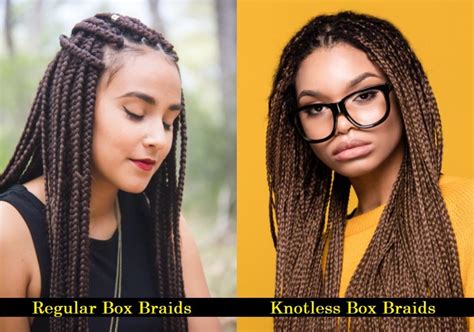Introduction
With an estimated 60% of Black women wearing their hair in braids at any given time, it’s no wonder that knotless and box braids have become two of the most popular protective styles. While both techniques involve braiding extensions into natural hair, there are key differences between the two that can impact the health of your scalp and the longevity of your style.

Knotless Braids
What Are Knotless Braids?
Knotless braids are a variation of box braids where the extensions are attached to the root of the hair without using any knots. Instead, the braider uses a special feeding technique to seamlessly blend the extensions into the natural hair. This creates a more natural and scalp-friendly style that reduces tension and promotes hair growth.
Benefits of Knotless Braids
- Reduced Tension: By eliminating knots, knotless braids reduce the amount of pulling on the scalp, which can prevent breakage and hair loss.
- Scalp Health: The knotless technique is gentler on the scalp, reducing the risk of irritation, inflammation, and scalp conditions like folliculitis.
- Longevity: Knotless braids can last for up to 8 weeks with proper care, making them a more long-lasting protective style than box braids.
Box Braids
What Are Box Braids?
Box braids are a classic protective style where square-shaped sections of hair are braided together with extensions. The braids are typically installed using a knotting technique, where the extensions are tied to the natural hair at the root.
Benefits of Box Braids
- Versatility: Box braids are incredibly versatile and can be styled in various ways, from buns to ponytails to intricate updos.
- Durability: Box braids are generally more durable than knotless braids and can withstand more manipulation without becoming loose.
- Quick Installation: Box braids are typically quicker to install than knotless braids due to the knotting technique.
Knotless vs. Box Braids: Key Differences
| Feature | Knotless Braids | Box Braids |
|---|---|---|
| Attachment Method | Knotless | Knotted |
| Tension on Scalp | Low | Moderate |
| Scalp Health | Gentle | Somewhat harsh |
| Longevity | Up to 8 weeks | 4-6 weeks |
| Installation Time | Longer | Shorter |
Choosing the Right Braiding Technique
The best braiding technique for you depends on your hair texture, scalp health, and desired style.
- Knotless braids are a better choice for people with fine hair, sensitive scalps, or those who want to minimize tension and promote hair growth.
- Box braids are more suitable for people with thicker hair, who prefer a more durable style, or who want to achieve a variety of looks.
Common Mistakes to Avoid
- Over-braiding: Braiding hair too tightly can damage the hair follicles and lead to hair loss.
- Not moisturizing: Keeping the scalp and braids moisturized is crucial for scalp health and preventing frizz.
- Sleeping with wet braids: Sleeping with wet braids can cause mildew and scalp irritation.
- Ignoring scalp care: The scalp needs to be properly cleansed and conditioned during and after braiding.
Frequently Asked Questions
- Can I wash knotless or box braids? Yes, but be gentle and use a sulfate-free shampoo.
- How often should I take down my braids? Every 4-8 weeks, depending on the technique used and your hair type.
- Can I trim my braids? Yes, but only the ends to prevent unraveling.
- How can I prevent scalp irritation with braids? Cleanse your scalp regularly, use anti-inflammatory products, and avoid tight braiding.
- Can I use heat on my braids? Yes, but use it sparingly and on a low setting.
- Can I sleep with braids in a ponytail? Yes, but tuck the ponytail into a silk or satin bonnet.
Conclusion
Knotless and box braids are both versatile and protective styling options. By understanding the differences between the two techniques, you can choose the best one for your hair and achieve the desired results. Remember to avoid common mistakes, take care of your scalp, and follow proper maintenance techniques to ensure the health and beauty of your braids.
